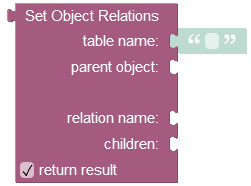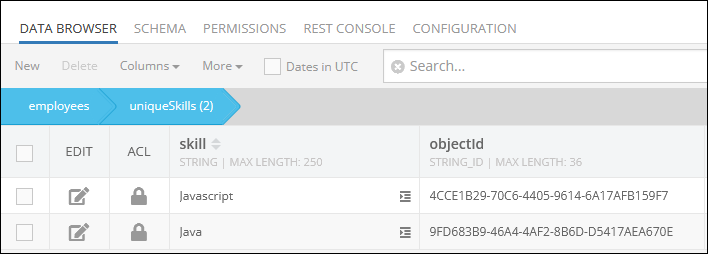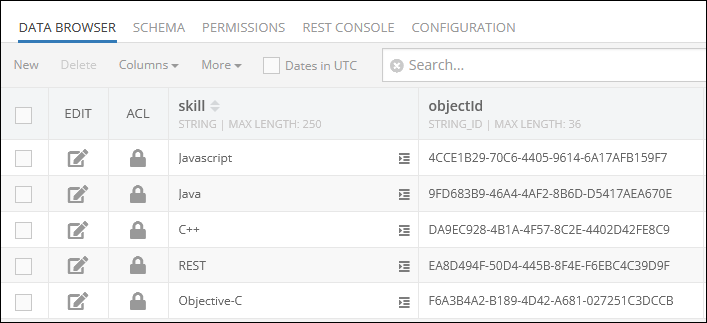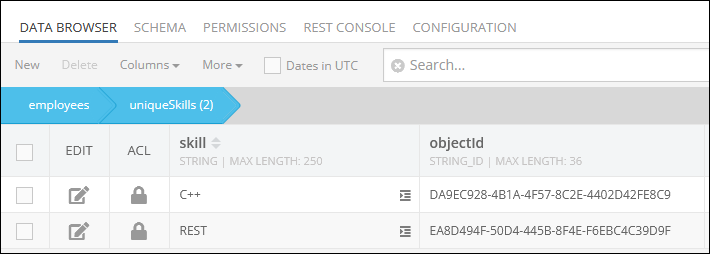Set Relation with objects¶
API request replaces related objects with the ones identified in the API call. Child objects must be explicitly defined by referencing their IDs.
Method¶
Future<int> Backendless.data.of("TABLE-NAME").setRelation(
String parentObjectId,
String relationColumnName,
{List<String> childrenObjectIds,
String whereClause});
Future<int> Backendless.data.withClass<E>().setRelation(
String parentObjectId,
String relationColumnName,
{List<String> childrenObjectIds,
String whereClause});
where:
| Argument | Description |
|---|---|
TABLE-NAME |
name of the table where the parent object is stored. |
E |
Dart class of the parent object. The class name identifies the table where the parent object is stored. |
parentObjectId |
The ID of an object which will be assigned related children for relatedColumnName. When this argument is an instance of Map (for the map-based approach), it must contain the "objectId" property. |
relationColumnName |
Name of the column identifying the relation. Objects from the children collection will be set as related for the column in parentObject. The column name may optionally include table name separated by the colon character as well as cardinality which determines the type of relationship (one to one or one to many) (see the note below): |
Important
If the column does not exist in the parent table at the time when the API is called, the value of the "relationColumnName " argument must include the name of the child table separated by colon and the cardinality notation. The cardinality is expressed as ":1 " for one-to-one relations and ":n " for one-to-many relations. For example, the value of "myOrder:Order:1 " will create a one-to-one relation column "myOrder " in the parent table. The column will point to the Order child table. Likewise, the value of "myOrder:Order:n " will create a one-to-many relation column "myOrder " pointing to the Order table.
| Argument | Description |
|---|---|
childrenObjectIds |
A collection of child object IDs to set into the relation identified by relatedColumnName. For the one-to-one relations the collection must contain one element. |
Return Value¶
Number of child objects set into the relation.
Example¶
The example below sets a relation for a one-to-one column named address declared in the Person table. The column must be declared in the table prior to the execution of the request shown below. This necessity is explained by missing table name qualifier in the relationColumnName argument - notice the relation column is "address". If the argument value were "address:Address:1", then the column would be created automatically.
Map parentObject = // parentObject retrieval is out of scope in this example
Map childObject = // childObject retrieval is out of scope in this example
Backendless.data.of("Person").setRelation(parentObject['objectId'], "address",
children: [childObject['objectId']]).then((response) {
// relation has been set
});
Person personObject = // personObject retrieval is out of scope in this example
Address addressObject = // addressObject retrieval is out of scope in this example
Backendless.data.withClass<Person>().setRelation(personObject.objectId, "address",
children: [addressObject.objectId]).then((response) {
// relation has been set
});
Codeless Reference¶
The update operation presented further replaces existing objects relations with the new ones.

where:
| Argument | Description |
|---|---|
table name |
Name of the table where which contains the parent object as identified by parent object. |
parent object |
Id of the object for which the relation will be created/set. |
relation name |
Name of the column which identifies the relation within the parent table (identified as table-name). The column name may optionally include table name separated by the colon character as well as cardinality which determines the type of relationship (one to one or one to many) (see the note below):If the column does not exist in the parent table at the time when the API is called, the value of the " relationColumnName" argument must include the name of the child table separated by colon and the cardinality notation. The cardinality is expressed as ":1" for one-to-one relations and ":n" for one-to-many relations. For example, the value of "myOrder:Order:1" will create a one-to-one relation column "myOrder" in the parent table. The column will point to the Order child table. Likewise, the value of "myOrder:Order:n" will create a one-to-many relation column "myOrder" pointing to the Order table. |
children |
A list containing unique identifiers(objectId) of the children objects that are used to update existing relations of the parent object. The objectId can be a string value or a number. |
Returns the number of newly set object relations.
The operation requires two data tables to update existing relations. Consider the first object with one-to-many relations(skills column) in the parent data table called employees:
By clicking the value (1:N Relations) in the skills column of the parent data table presented above, you get redirected to the child data table called uniqueSkills, where you can see the related children objects:

Suppose, you want to set new relations between the parent object in the employees data table and the third/fifth objects(having values REST and C++) in the uniqueSkills data table presented below:

The example below updates the current relations for the parent object. Children objects that are used to update existing relations:
-
(
skill: REST, objectId: DA9EC928-4B1A-4F57-8C2E-4402D42FE8C9) -
(
skill: C++, objectId: EA8D494F-50D4-445B-8F4E-F6EBC4C39D9F)

As you can see, this operation has replaced the old relations(objects having Javascript and Java values) with the new ones(objects having C++ and REST values):
